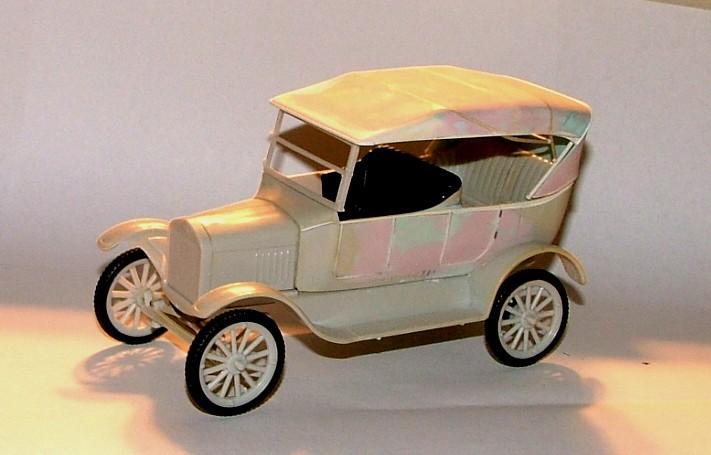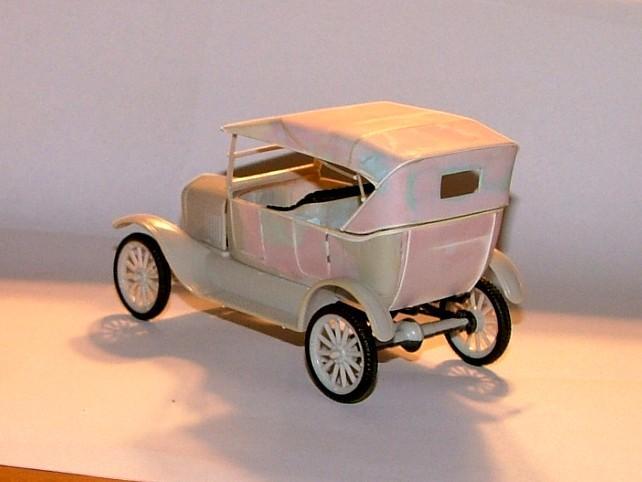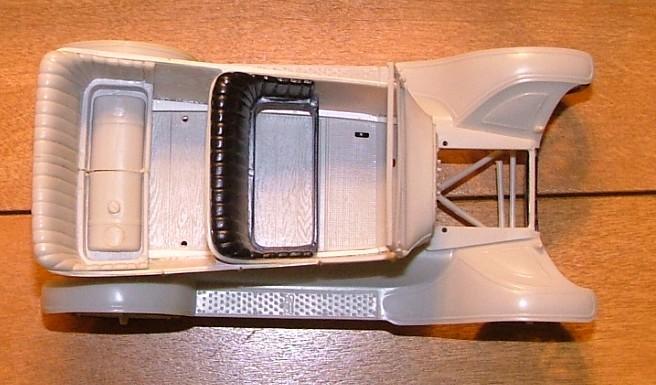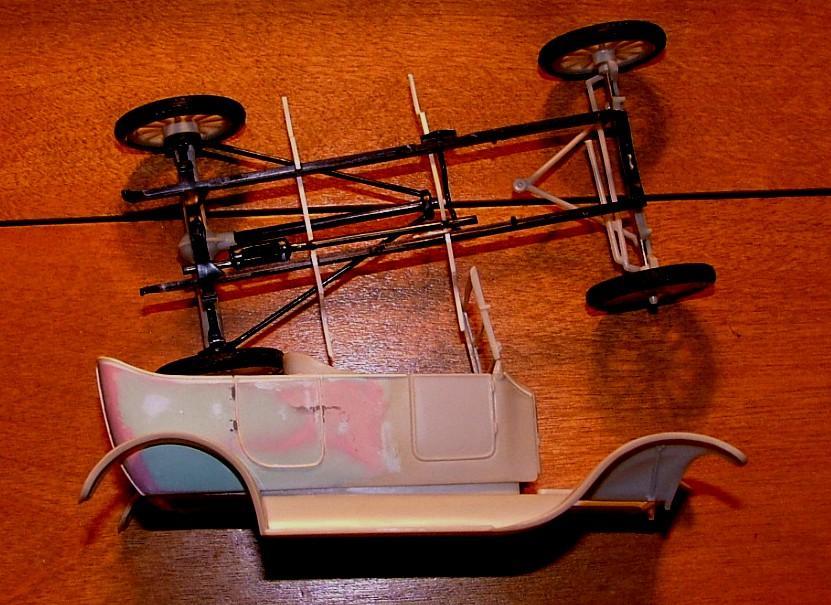
Art Anderson
Members-
Posts
5,052 -
Joined
-
Last visited
Content Type
Profiles
Forums
Events
Gallery
Everything posted by Art Anderson
-
1957 Ford Engine Color
Art Anderson replied to Jim B's topic in Model Building Questions and Answers
I believe that the metallic bronze came about in 1949, but later in the year. Here's a 1950 Ford flathead V8 in bronze, in a Country Squire wagon: No, that Ford engine color is a dark metallic copper, AKA bronze. http://www.popularrestorations.com/images/Restorations/Restoration011/data/images/1950_ford_engine_bay.jpg -
Bear in mind, in the 1960's, ANY model car kit (indeed ANY plastic model kit) resulted from tooling patterns that were hand-carved by hand--thus subject to the interpretations of the pattern-maker, even the draftsman who did the drawings. In addition, given the frantic pace at which Monogram (and all the other model companies) was releasing new model kits (of all subjects), time frames were very short. There simply just was not much time to study, carve, re-study, make corrections here and there. There were a lot of inaccuracies in model kits of all subjects back then and given that pretty much all subject areas of plastic model building were primarily kids--no IPMS-style rivet counters to argue. Art
-
1957 Ford Engine Color
Art Anderson replied to Jim B's topic in Model Building Questions and Answers
-
One more thing: When I've soldered up brass for model work, I've settled on Stay-Bright Silver Solder, which is a low temperature silver solder, and comes with flux. The advantages of silver solder are (1) it's far stronger than ordinary lead-tin solder, and (2) it takes more heat to melt a silver solder joint than it does to make it in the first place, making assembly a whole lot easier. Also, be looking for a set of miniature needle files (3-4 inches long), as the round or "rat tail" files in those sets are perfect for "fishmouthing" the ends of pieces of rod or tubing that one is going to join in a "tee joint". Also, those needle files are great for smoothing solder joints as well. Art
-
Kits gone at WalMart again
Art Anderson replied to Greg Myers's topic in General Automotive Talk (Trucks and Cars)
From my experiences at Playing Mantis (Johnny Lightning), Walmart (and the other Big Box outfits as well) began downsizing their toy departments after the 1993 Christmas selling season, to make way (those stores are limited in size, BTW) to make way for other merchandise lines that would turn over faster, be more profitable. Most are perhaps unaware anymore that 9/11, in many ways burst a lot of bubbles in retailing for the holiday season. The toy industry (and like it or not, to those retailers, model kits are toys!) took a major hit in 2001, and '02 & '03 were in many ways just as dismal. Think of it this way: Model car kits take up a lot more cubic feet of selling space than say, hooks of blister carded stuff---a dozen or more bubble-packed toys can fit on a pegboard hook, and turn faster than the 4-6 model kits that take up the same amount of space. As Tom has so wisely reminded--Walmart et.al. have little sympathy where issues of inventory turnover are concerned. However, there is an upside: Losing the big box store market forced model companies to get going, develop new products that while pricier, are more the model cars we get excited about today. Most of the more esoteric models seen from US model companies likely would never have seen the light of day, were their industry so dominated by mass merchandisers as it was for a few decades in the not-to-distant past. Art -
Kits gone at WalMart again
Art Anderson replied to Greg Myers's topic in General Automotive Talk (Trucks and Cars)
I've said it once before, and I repeat: Walmart stopped stocking model kits as a general, staple category in their toy departments in 2005. Art -
You can use one of two measurement systems, Michael: In metric, 1mm is so very close to an inch in 1/25 that any discrepancy won't be noticeable with small diameter rod or tubing. Or, in English measure, .040" is exactly one scale inch in 1/25. K&S has started marketing brass rod & tubing in metric diameters, but I suspect their English measure rod stock is still out there. For starters, think of 1/8" as being quite close to 3" in 1/25 scale, being barely a sheet of copier paper thicker; 3/32" stock being close enough to 2" and so on. Art
-
Of course, one can always use K&S brass rod stock--that bends without collapsing as tubing is prone to do. Low temperature silver solder does a great job with brass as well. Art
-
Cadillac 355cid V12 engine: https://upload.wikimedia.org/wikipedia/commons/1/1e/1931Cadillac370AcoupeV12-engine.jpg Cadillac 452cid V16 engine: http://images57.fotki.com/v1418/file1Mz8/885fa/4/43743/1172716/CadillacV161.jpg Note also, the two sides of these engines are virtually identical, left to right, each bank of cylinders being pretty much a "mirror image" of the other. It shouldn't be all that difficult to rework the JoHan V16 into the V12. Bellhousing and transmissions are the same for both engines. Art
-
Cadillac's V12 is virtually identical to the V16, just 2 cylinders shorter (of course, on each cylinder bank). As for the wheelbase and hood length, yes, both are shorter on the V12 than the V16 cars. For reference, the 1931 Cadillac V16 cars were 222.5" overall length, with a wheelbase of 148". I believe this difference is primarily in the engine bay. The Model 355 V12 cars had an overall length of 209", with a wheelbase of 140". The difference in overall length was accentuated with the Model 452 V16 chassis, given that this series Cadillac had significantly larger bodies than were cataloged for the V12 Model 355. Art
-
LHD v RHD USA
Art Anderson replied to Earl Marischal's topic in General Automotive Talk (Trucks and Cars)
As a sidebar here: In the UK, railroad trains on double track run, as standard procedure, on the left hand track. In the US, all railroads using double tracks run, as standard procedure on the right hand track--save for one railroad: The Chicago & Northwestern Railway was built with British capital, and that RR adopted the British running standard, held to that for over a century. Art -
Amen! Art
-
LHD v RHD USA
Art Anderson replied to Earl Marischal's topic in General Automotive Talk (Trucks and Cars)
For starters, driving vehicles on the right side of the road or street has been the standard here in the US since our beginnings. Early automobiles here came with both left- and right-hand-drive, for one simple reason: It was considered dangerous by some early automakers for the driver to enter his car from the left, or street-side. However, it was Packard, followed by Ford, who pretty much standardized American cars to LHD. The rationale there is, while a driver enters the car from the left, or traffic side, passengers can enter the car from the curb--deemed much safer. Also, with the advent of first the large fabric tops on roadsters and touring cars, the driver of a vehicle following one is better positioned to see on-coming traffic. Art -
Paint Fogging, Strange Reaction
Art Anderson replied to StevenGuthmiller's topic in Model Building Questions and Answers
Steve, you mention that you work in the basement of your house: Even though your basement sounds as though it's part of central air conditioning, I'd be willing to bet that it's still more humid down there than upstairs, given that you live in MN, where ground temperatures stay pretty cool even in the summer. "Fogging" or hazing of lacquers or lacquer-based paints happens when moisture condenses on the little droplets of paint coming out of a rattle can as well as on wet-paint surface of a model (or any other object being so-sprayed, in my experience) for one simple reason: When you release pressure on an aerosol can, as the compressed propellant escapes, it drops dramatically in temperature (which is why the cautionary statement on those cans of compressed gas people use to clean dust off and out of puter keyboards--warning about possibly freezing skin if you spray directly on it). This in turn, chills down the minute droplets of lacquer coming out of that nozzle, enough to cause water vapor to condense on them. It's not a chemical reaction--rather it has a lot to do with the laws of physics. Except in an extremely humid environment, I've almost NEVER had "hazing" (that almost pearlescent looking surface) when airbrushing lacquers, regardless of humidity, but I do know that my nephew and brother, who are partners in the cabinet-making and antique furniture restoration have been known to have problems in certain highly humid weather conditions. A solution may very well be as close as your nearest appliance store: A dehumifier--which will dry out the air in an enclosed room fairly quickly. I know they aren't cheap, but if you consider that it'd be a one-time buy, that you can use for many years, the price per year, not to mention the reduction in the costs of spray painting model cars should drop dramatically (and your model building satisfaction increase in the bargain!). Of course, in the dead of winter, unless you have a humidifier to lessen the extremely dry air in bitter outdoor cold, you should not see this problem, as the combination of heating along with the already greatly lower relative humidity outdoors on a 0-degree evening generally dries out the air inside a house dramatically. Art -
Opel Blitz question
Art Anderson replied to Superpeterbilt's topic in General Automotive Talk (Trucks and Cars)
The first series Opel Blitz and Admiral engines were the same as the Chevrolet 216/235 inline six as used in US production, for the simple reason that from their introduction in both the US and Germany in 1937 until sometime in the spring of 1939, Chevrolet built all those engines for Opel in Flint MI, stopping only when the German Government decreed that all such engines (this hit Ford as well) produced for installation in German-produced vehicles be manufactured in Germany. (from my extensive research when working up the ICM Opel Admirail Kabriolet this time last year.) Art -
Could it be done (50/53 Cadillac)
Art Anderson replied to om617's topic in General Automotive Talk (Trucks and Cars)
Unfortunately, not even close! Bear in mind, GM used three body series back in the 1950's, Chevrolet & Pontiac used the A Body, Oldsmobile shared the A Body for 1949-50 and used the B-body, which was shared with Buick, Buick also in a few model years, used the C-body which was shared with Cadillac. Cadillac used the C body only though. Art -
identifying the problem / paint question
Art Anderson replied to ERIK88's topic in Model Building Questions and Answers
"Air" bubbles in spray paint is a problem as old as rattle cans themselves, particularly enamels (I discovered this problem back in 1959 with the very first paintjobs I did with the then-newly-released Pactra 'Namel "Soft Spray" paint for plastic models. This problem is caused by humidity--it can cause enamels to "skin over" very quickly which I've found is the primary cause of "hazing" with both rattle can enamels and lacquers. "Hazing" itself, is curable--it polishes right out. Those nasty little air bubbles are another matter entirely: When the paint (particularly enamels) "skins" over too rapidly, the paint has still not out-gassed its propellant gas (spray can propellant does get dissolved into the paint, in the can, under the rather high PSI needed in order to propel the paint out in a fine spray). If the paint surface dries too quickly, that gas (generally propane nowadays, BTW) has no place to go, and as with bubbles in a glass of soda, they tend to gather together in ever larger bubbles. There really is no solution to this problem other than stripping the paint, and starting all over. Living in the Great Lakes region, we all face this at some time or another--the only thing to do is wait either for the humidity to drop, or paint in the heat of day when the relative humidity is lower than it would be say, at night. Another solution is to paint indoors, with airconditioning (will take some work to keep the rest of the family happy though!), or get a dehumidifier, which will dry out the air inside the house (or at least in a room) enough to prevent this from happening. Also, I'd wait for the paint to begin to dry, at least to the "tacky" stage, before putting it in the dehydrator (which device I use religiously BTW), so the propellant has as much time as possible to out-gas before the surface of the paint traps it. Art (who's been spray painting model car body shells (both aerosol can AND airbrush) for now a good 56 years. -
Red oxide primer undercarriage?
Art Anderson replied to ERIK88's topic in Model Building Questions and Answers
Primer colors (shades thereof) also varied from paint manufacturer to paint manufacturer, particularly red oxide. From the time in the early 1920's when the DuPont family stepped in and rescued GM from sure bankruptcy (due to President William Craop Durant's second round of stock speculation with company funds!), DuPont was the exclusive supplier of lacquers (from nitrocellose to acrylic) to all GM plants. This ended in the mid-1960's when the government began to knock on GM's door. Ford, from their beginning in using lacquer finishes beginning in late 1925, went with Ditzler, and stayed with PPG-Ditzler for decades afterward. But, at least into the early-mid 1960's, all I saw as OEM primer (I had three body shops on my rather large Indianapolis Star morning paper route 1956-61, age 11-16), and got to see a lot of cars being repaired, couldn't help but notice the "edge" of primer around areas of sheet metal under repair--and I don't remember EVER seeing anything but red oxide. I did see a couple of antique cars under restoration at Demerly's Body Shop though, and they were using gray primer as a guide coat (a coat of red oxide followed by a coat of gray, and saw the resuts when they sanded that out (remember, this was back in the day when body shops were still working with body solder--lead if you will-- with torch and wooden paddles for spreading it out). But, no matter what color a primer was used, back then, the final primer used was always red oxide. In addition, in June 1960 (I was 15 at the time) I was privileged to have won a week's trip to St Louis from a newsboys' sales contest, which included a "most of the day" tour of the Chevrolet (and Fisher Body Division) assembly plant in St. Louis. The 1960 Chevies we saw being built all had red oxide primer under their body color (got to see the paint department!). I'd be willing to bet that for the first 40 years ago, or so, vitually all paints used in the auto industry were created for use over red oxide, as surely with lighter, brighter paints, the color of the primer could cause variations in the final shade. In addition, auto company advertizing, beginning with American Motors (and Volkswagen) back then frequently touted their "rust control" (severe rusting was an issue for a long time after the industry introduced full-width "envelope" body shells, with running boards and fenders extending outward from the body sides no longer there to prevent splashing. Those pictures in the likes of LIFE Magazine, Saturday Evening Post, Collier's clearly showed the use of red oxide. On the other hand, I bought, new, a 1970 Barracuda in June 1970, and got to watch the dealer prep. The car was up on a lift when I got there, and it was clearly red oxide underneath (built in Hamtramck MI, btw), but a year later, as scuffed dent exposed GRAY primer, so go figure. Fast forward to 1990: I bought a brand-new '90 Plymouth Grand Voyager, and when I saw it on the lift at the dealership, the entire underside of that van was NOT in primer! Rather, it had been painted, at the factory, in the lower body color, and as nicely as the exterior surfaces at that! Nothing like robotic painting! Art -
That Royal Navy Flower Class Corvette was an expensive kit when Matchbox first released it back in the late 1970's. It's huge, at 1/72nd scale, required several injection-molding operations to produce, due to its size (the hull itself is in 4 sections, divided down the center (like many plastic ship model hulls) and across amidship. In addition, there's a ton of smaller parts as well. The market for such a large kit (more than 4' long when built) was, and still is, limited due to this--not all that many modelers have the room to build, let alone display a model that big. The same thing has been true of the equally large, highly detailed plastic model warship kits that the Japanese model companies (even a couple of Chinese model kit mfrs as well) have brought to market over the past 35-40 years or so. Almost as important from a cost standpoint, model kits of ships, of any size/scale, have always had a much smaller market, almost a "sub-set" of the plastic modeling hobby if you will. This alone means that tooling/production costs have to be spread across a smaller volume of sales, which again raises the price that has to be charged, if whomever runs the kit is to come out in the black on a production run. With the sheer magnitude of this particular model kit, it's little wonder that it has always been high-priced, and even more important, it was part of Lesney's downfall, at trying to go head-to-head with the much bigger hobby/toy companies worldwide (remember, Lesney went bankrupt in the late winter of 1982, much of that company's product line literally disappearing into the mists of time, with Mattel picking up Matchbox Toys for peanuts, Ertl snagging all the AMT model kit tooling for a song as well. Even today, this model kit generates a lot of wishful interest, but every time it's been reissued by whomever, it's pretty much always been a rather small production run, due to its size and complexity--coupled with the still-rather-narrow market for model kits of ships. Art
-
As has been said virtually every time this sort of thing gets brought up: It's not you average modeler who is paying the likes of Paul Hettick that kind of money for a built and finished model. Rather, he has a following of model car enthusiasts with the ability to pay a premium price for a very well built model car or pickup, but lack either the time or the skills to achieve such on their own. Pretty simple. Art
-
Strange business practices?
Art Anderson replied to Harry P.'s topic in General Automotive Talk (Trucks and Cars)
The whole tariff thing is a big part of the equation: Even here in the US, back when the old Interstate Commerce Commission administered (regulated) freight rates (we are talking up to about the middle 1970's, the shipping rate that had to be charged (no more, no less!) depended on the classification of the goods being shipped by truck or train interstate! Believe it or not, I've signed delivery tickets that plainly stated that those cartons of plastic model kits were indeed "unassembled wooden toys"! All because that was a lower regulated shipping charge than "plastic toys" (apparently the ICC hadn't heard that there was such a thing as an unassembled plastic model. The same thing is true of import tariff schedules: For a thousand different items, there can be a thousand different tariffs to be paid at the point of entry--unassembled items come in at a lower rate. In addition, the cartons of "bagged plastic shots" can be more densely (read that more product in the same size cartons) packed for bulk shipping, which serves to reduce the cubic feet (or meters) of space needed in a seagoing/rail riding seaborne container. This does two things: It reduces the shipping weight of each kit by the weight of what would be each individual cardboard kit box (send say, 24,000 model car kits, think of the sheer weight of all those model kit boxes alone!) in addition to saving on the weight of 2,000 standard corrugated 12-kit shipping cartons. That's a lot of weight right there. Now, multiply that by all the hundreds of seagoing steel containers and you are talking about many thousand tons of just tare weight alone, and I haven't even mentioned the tying up of available space on that massive container ship. Add to this potential savings the lower import tariffs on unfinished goods (in this case, unfinished model car kits, and it does add up to a significant savings to the likes of say, Revell. I'd be quite certain that cost to a model company (if they have a US model kit final assembly line) is far less than the money saved by having those overseas-mfr'd plastic kit parts trees and all the other bits and ;pieces that are part of a model kit assembled on at least a semi-automated asssembly line here in the US. Art -
Gasser escape hatches?
Art Anderson replied to Roadrunner's topic in Model Building Questions and Answers
Cars of the era of the Willys-Overland Model 77 were still using composite bodies, of wood structure with sheet metal skin--the so-called "turret top" (one piece sheetmetal top stamping) didn't arrive until GM introduced them across their line for 1936. So, with closed bodies such as the Willys Coupe, the center section of the roof was built wth ribs and a padded fabric that was waterproofed. Art -
That Pace Car also was a V12, not the V16.
-
1925 Ford model T touring car
Art Anderson replied to misterNNL's topic in Model Building Questions and Answers



